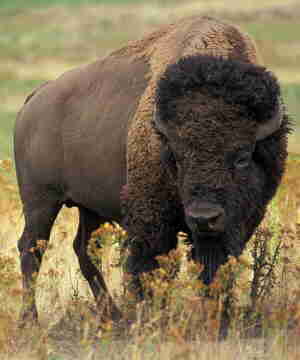 SKC Films Library SKC Films Library |
| SKC Films Library >> Science >> Zoology >> Mammals >> Order Artiodactyla >> Family Bovidae |
| American Bison Bison bison
Description The American bison is the largest living land animal native to North America. Adult bulls average 10-12½ feet in length from the tip of its nose to the end of its short tail, stands 5½-6 feet at the shoulders, and weighs 1,600-2,000 pounds; cows are much smaller, rarely weighing more than 900 pounds. Both sexes have horns, which on males can be up to 35 inches across. The coat color is generally brownish-black, but tends to be more brown on the hind part. Long, coarse hair covers the head, neck, and shoulder hump, and forms a "beard" on the throat and chin. Bison have poor eyesight, but acute hearing and an excellent sense of smell. Although it is often called a buffalo, the American bison is not even in the same sub-family as true buffalo, a name that zoologists reserve for the water buffalo of Asia and the cape buffalo of southern Africa. The American bison is distinguished from buffalo by its broad, massive head, short, thick neck, prominent shoulder hump, and relatively small hindquarters; it also has 14 pairs of ribs, as opposed to the 13 of buffalo. Distribution and Habitat Bison historically ranged throughout the grasslands and open savannas of North America, from northern Canada into central Mexico, and once roamed in herds numbering in the thousands. Extensive hunting in the mid-1800's all but exterminated the species, however, and by the end of the 1800's there were almost no bison left in the wild. Fortunately a few dedicated conservationists managed to save a few small herds and preserve the species. While there are no truly wild bison herds left, there are numerous privately maintained herds on private and protected lands in the western United States and Canada.
Habits and Behaviors Bison are very social animals, and where possible congregate in large herds. These herds are usually broken up into smaller groups according to age and sex. Bison may appear to be rather slow, awkward and somewhat lazy, but are actually capable of running at speeds of up to 35 miles per hour and can traverse long distances at a fairly quick "gallop." They are also very quick-tempered and have been known to attack anyone or anything with no warning and for no apparent reason. Diet In the wild bison feed almost exclusively on grass, which is pulled up rather than bitten off. When grass is less plentiful they will also feed on small plants, twigs, and some bark. "Domesticated" bison will eat hay and other forage, but still require a steady supply of fresh grasses to stay healthy. Reproduction The breeding season runs from late June through September, during which time dominant bulls will attempt to restrict access to small groups of females. A single yellowish-brown calf is born after a gestation of about 285 days. The calf typically weighs between 30 and 70 days, and can walk and feed on its own within a few hours of birth. It is weaned at about seven months, becomes independent at one year, and will be sexually mature at three years.
The average life span of a bison in the wild is 15-20 years, but it is not uncommon for an individual to live as long as 30 years or so. Scientific Classification phylum Chordata SOURCE SEE ALSO |
| SKC Films Library >> Science >> Zoology >> Mammals >> Order Artiodactyla
>> Family
Bovidae This page was last updated on June 11, 2017. |


